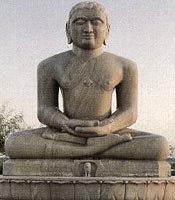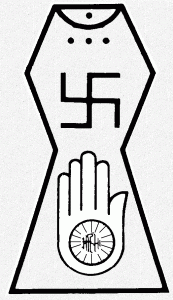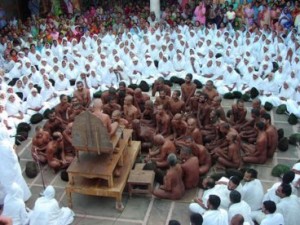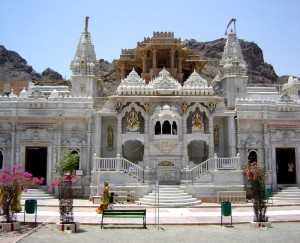Jainism
The word ‘Jainism’ comes from the root word ‘ji’ which means “to conquer”.
It is a movement, like Buddhism, that rejects the caste system. It also emerged around the same time as Buddhism and was founded by Vardhamana Mahavira. Mahavira was a Hindu but found, like Siddhartha Gautama did with Buddhism, that there was another way to attain enlightenment; not just by listening to the Brahmins read and teach the Vedic text. Both Gautama and Mahavira did not agree with the high praise given to the Brahmins and the disgust bestowed upon the lowest castes. They wanted to do away with caste, saying that every man was equal.
Mahavira was the last of a long line (24) of Tirthankaras who each discovered a way to achieve enlightenment aside from the traditional Hindu way. Mahavira was walking when he attained enlightenment, and so walking is very important to Jains (Dalrymple, William. “Nine Lives”. 2009).
Source: http://www.thecolorsofindia.com/mahavir/
Triratna:
-The Three Jewels of Jainism:
- Right belief
- Right knowledge
- Right conduct
Tapasya:
-“Through their (the Tirthankaras) tapasya – bodily austerities – they gained omniscient and transcendent knowledge which revealed to them the nature of the reality of the great theatre of the universe, in every dimension” (Dalrymple, William. “Nine Lives”. 2009).
-This includes:
- Walking, through which Mahavira attained Moksha.
- A withdrawal from the world and its material possessions.
- Fasting on certain days.
- Concentration and effort to always be aware of what one is doing so as to ensure that they will not harm another living creature.
- Sallekhana- fasting to the death. (Not all monks/nuns/laypeople do this. It is only for those who are ready to do it since it requires intense concentration and effort to deny the body the nutrients it needs. Only after a practitioner has been questioned by a leader and approved for starting the process are they allowed to do Sallekhana.)
-Tapasya rids the self of kharma – the gunk that needs to be gotten rid of.
The Jain Symbol and its Meaning:
Source: http://www.jainworld.com/education/jainsymbol.htm
-Each part of the symbol has a specific meaning:
- Outline= Universe
- Raised palm= pause and reflect on life; part of ahimsa
- Swastika (not the same as the Nazi one; the Nazi’s swastika is tilted 45°) = Four destinies:
- Heavenly beings
- Human beings (This destiny is considered to be the best one to be born into because humans recognize that they are in samsara and need to achieve moksha.)
- Animal beings
- Ghostly beings
- The Swastika also represents the Four pillars of Jain sangh (a community or association). Each group is a pillar because each is equally important to the practice of the religion; one group is not higher than the others:
- Monks
- Nuns
- Laymen
- Laywomen
- Three dots= Three Jewels
- Arc= Siddhaloka, the abode of the Siddhas (liberated souls)
Five Vows:
- Ahimsa (non-harming)
- Satya (truth)
- Aparigraha (non-attachment)
- Achaurya/Asteya* (non-stealing)
- Brahmacharya* (celibacy/chastity)
*http://www.fas.harvard.edu/~pluralsm/affiliates/jainism/jainedu/5greatvows.htm)
Jinas:
-The Jinas (as stated above) are the enlightened being in Jainism. They are reflexive, meaning that people learn from them to become like them. The reflexive state is one of meditation, and the Jinas teach the believers how to become enlightened. They leave behind teachings, writings, and examples of how to live one’s life in order to continue to teach devotees long after the Jina has died.
Ahimsa:
-While Ahimsa most assuredly means non-violence and non-harming, there is more to the act than that. Ahimsa is also asking that any accidental violence done by the devotee (such as stepping on a small animal or being responsible for the death of something or someone) be forgiven and so not considered kharma. Jains do not want any kharma, good or bad; Hindus just do not like negative kharma.
-Ahimsa is practiced many different ways:
- Believers carry large feathers and lightly sweep the ground in front of them as they walk. This minimizes the chances that an insect or other small creature will be stepped on.
- Believers do not go outside during the monsoon season, as the ground is not visible and most likely there are insects and animals in the water that can be then hurt or killed by a human walking through the water.
- When an insect is found in the practitioner’s food (most likely a bowl of rice or oats of some kind), the practitioners sets aside the bowl and, depending on depth of belief/practice, will either not finish that meal or not eat for the rest of the day. The more serious and devoted followers (monks and nuns) practice the latter.
Lay community:
-In Jainism, the Lay community, while it does not hold any leadership role, is vital to the Jain religion. They give money and supplies to the monasteries, allowing the Monks and Nuns to focus on religious rituals and practices.
-Lay people should:
- Practice self-restraint
- Avoid meat, wine, honey, and night-snacking
- Not lie, steal, or commit acts of violence
- Support the renouncers
- Practice Puja
Puja:
-In the section on Hinduism we learned that Puja is the offering of sacrifices to the gods. These sacrifices include: sound (music), rice, water, flowers, powder, incense, light, and fruit.
-In Jainism, Puja can be done individually or communally. In India, Puja is carried out by the females in the family, most likely the wife of the eldest son (girls marry into families and live with their husband and his family, where the husband’s mother is in charge of the family’s affairs).
Two Communities:
-In Jainism, there are two communities of believers. They are the Svetembara and the Digambara. People of the Svetembara community wear white clothing while the people of the Digambara community do not wear any clothing.
Source: http://www.world-religions-professor.com/digambara.html
Important Figure(s):
-Vardhamana Mahvira (599-527 B.C.E.)
- Last of the 24 tirthankaras (“ford-makers”; those who have achieved moksha and lead the way for those after)
- Attained Moksha (enlightenment) at age 42
Holidays*:
Because Jains are so devoted to not being attached, they have very few festivals. The most notable of which is the one below.
-Mahavir Jayanti- This festival, named after the last of the 24 tirthankaras, celebrates his birth (c. 599 B.C.E.).
*Source: http://en.wikipedia.org/wiki/Public_holidays_in_India#Jain_holidays
Vocabulary:
-Mandir- Jain temple
Source: http://www.shreenakoda.com/History.htm
-Puja- Jain devotional worship
-Tirthankara- “Ford-maker” (there are 24 of them). They create a crossing place between samsara and liberation. Their souls are not believed to be present in their statues. They are not considered deities or reincarnations of deities.
-Ahimsa- Non-harming; non-violence
-Sallekhana- Fasting to the death; a severe form of self-purification.
-Jinas- Enlightened being.
-Dadagurus- Ascetics; they are considered to be divine.
-Diksha- Initiation into Monastic life.
-Guru/Acharya- Teacher; Spiritual leader.
-Tapasya- Austerity (physical and spiritual practices such as walking). This rids the self of kharma.
-Satya- Adherence to truth. No hiding of the truth or lying, except to avoid violence.
-Aparigraha- Non-attachment; ownership is distracting. For lay people this means limitation on what is owned. Monks and Nuns do not own anything.




